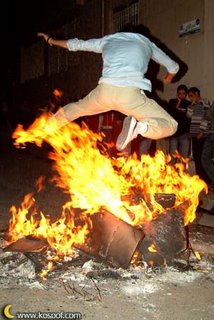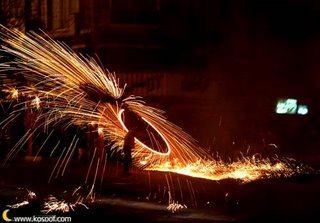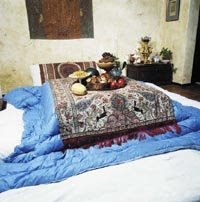Noruz

NoruzNorouz (alternative spellings: Norooz, Noruz, Nowrouz, ...) [from Persian no=new + rooz=day meaning "new day"] is the traditional Iranian festival of the New Year which starts at the exact moment of the vernal equinox, commencing the start of the spring. Iranians take that as the beginning of the year. Norouz with its uniquely Iranian characteristics has been celebrated for at least 3,000 years and is deeply rooted in the rituals and traditions of the Zoroastrian religion. Today the festival of Norouz is not only celebrated in Iran, but also in many lands that historically have been within the Persian sphere of cultural influence (i.e., lands which have been main parts of the pre-islamic Persia.)Iranians consider the Norouz as their greatest celebration of the year. Even after Islam, the festival of Norouz continued to be by far the greatest celebration of the year in Iran. Iranians start prepari
 ng for the Norouz by a major springcleaning of their houses, buying new clothes to wear on the day of Norouz, buying lots of flowers for the Norouz (in particular the Hyacinth and the Tulip are popular and conspicuous in the Norouz) during the last month of winter in the Persian solar calendar. Another major tradition of Norouz is setting the "Haft Seen" (the seven 'seen', 7-Seen or the 7 items) with seven specific items symbolically corresponding to the seven creations and the seven holy immortals protecting them. Today they are changed and modified but some have kept their symbolism. Every family tries to set up as beautifully a 7-seen table
ng for the Norouz by a major springcleaning of their houses, buying new clothes to wear on the day of Norouz, buying lots of flowers for the Norouz (in particular the Hyacinth and the Tulip are popular and conspicuous in the Norouz) during the last month of winter in the Persian solar calendar. Another major tradition of Norouz is setting the "Haft Seen" (the seven 'seen', 7-Seen or the 7 items) with seven specific items symbolically corresponding to the seven creations and the seven holy immortals protecting them. Today they are changed and modified but some have kept their symbolism. Every family tries to set up as beautifully a 7-seen table as they can, as it is not only of special spritual meaning to them, but also is noticed by visitors to their house during Norouzi visitations and is a reflection of their good taste.During the Norouz holidays Iranians are expected to pay house visits to one another (mostly limited to families, friends and neighbours) in the form of short house visits and the other side will also pay you a visit during the holidays before the 13th day of the Spring. Typically, on the first day of Norouz, family members gather around the table, with the 7-seen on the table or set next to it, an await the exact moment of the arrival of the Spring. At that time gifts are exchanged. Later in the day, on the very first day, the first house visits are paid to the most senior family members. Typically, the youngers visit the elders first, and the elders return their visit later. The visits are not by appointment and naturally they have to be relati
as they can, as it is not only of special spritual meaning to them, but also is noticed by visitors to their house during Norouzi visitations and is a reflection of their good taste.During the Norouz holidays Iranians are expected to pay house visits to one another (mostly limited to families, friends and neighbours) in the form of short house visits and the other side will also pay you a visit during the holidays before the 13th day of the Spring. Typically, on the first day of Norouz, family members gather around the table, with the 7-seen on the table or set next to it, an await the exact moment of the arrival of the Spring. At that time gifts are exchanged. Later in the day, on the very first day, the first house visits are paid to the most senior family members. Typically, the youngers visit the elders first, and the elders return their visit later. The visits are not by appointment and naturally they have to be relati vely short, otherwise one will not be able to visit everybody on their list. Every family announces in advance to their relatives and freidns which days of the holidays are their reception days. A typical visit is around 30 minutes, where you often run into other visiting relatives and friends who happen to be paying a visit to the same house at that time. Because of the house visits, you make sure you have a sufficient supply of pastry, cookies, fresh and dried fruits on hand, as you typically serve your visitors with these items plus tea or syrup.The 13th day of the New Year festival is called "Sizdah Bedar". People go out in the nature in groups and spend all day outdoors in the nature in form of family picnics. It is a day of festivity in the nature, where children play and music and dancing is abundant. On this day, people throw their Sabze (green sprouts that they grew as one of the 7-seen items) away in the nature as a symbolic act of making the nature greener. The official calendar of Iran is the Persian solar calendar, and the first day of the Persian new year is the 1st of Farvardin, and this day is called Norouz, meaning New Day. In the Persian solar calendar there are 12 months, the first 6 months have 31 days, and the second 6 months have 30 days, except the last month which has 29 days, but has 30 days only in leap years. In the Gregorian solar calendar, the Norouz corresponds to March 21 of every year .
vely short, otherwise one will not be able to visit everybody on their list. Every family announces in advance to their relatives and freidns which days of the holidays are their reception days. A typical visit is around 30 minutes, where you often run into other visiting relatives and friends who happen to be paying a visit to the same house at that time. Because of the house visits, you make sure you have a sufficient supply of pastry, cookies, fresh and dried fruits on hand, as you typically serve your visitors with these items plus tea or syrup.The 13th day of the New Year festival is called "Sizdah Bedar". People go out in the nature in groups and spend all day outdoors in the nature in form of family picnics. It is a day of festivity in the nature, where children play and music and dancing is abundant. On this day, people throw their Sabze (green sprouts that they grew as one of the 7-seen items) away in the nature as a symbolic act of making the nature greener. The official calendar of Iran is the Persian solar calendar, and the first day of the Persian new year is the 1st of Farvardin, and this day is called Norouz, meaning New Day. In the Persian solar calendar there are 12 months, the first 6 months have 31 days, and the second 6 months have 30 days, except the last month which has 29 days, but has 30 days only in leap years. In the Gregorian solar calendar, the Norouz corresponds to March 21 of every year .home








.jpg)
